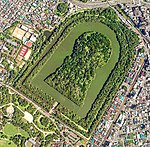|
Inaridai Kofun Group
The Inaridai Kofun Group (稲荷台古墳群) is a Kofun cluster or a group of Kofun located in the Chiba Prefecture.[1] FindingsThe cluster includes Inaridai Kofun No. 1 Kofun, which is the kofun the Inaridai Sword was taken from.[2] Some of the earliest pottery in the Kantō region has been found in this Kofun, giving its name to the type.[3] LocationLocated on the west of the Bōsō Peninsula and just east of Tokyo, Inaridai is part of a concentration of early archaeological sites, which also includes Shakujii, in Tokyo's Nerima ward among others. Northeast of these locations are the later sites, categorized as Proto-Jomon. These Proto-Jomon sites are distinguished by pottery that predominantly features fiber or cord impressions.[1] In the Miura Peninsula, pottery has shell marks. In the Western Kanto Plain, pottery changed from fiber marks to cord marks. Inaridai is a key site in this change.[1] Usage in periodizationThe Kofun cluster gives its name to Inaridai pottery, the oldest pottery type in the Kantō region.[3] The Inaridai No. 1 Kofun and the Inaridai Kofun group are found in the Kanto loam layer. This layer has both early Jomon pottery types like Inaridai, Haijima, and Tado I and other artifacts.[3] It is also used as a categorization for figurines.[4] and other implements.[5][6] In the Kanto valley of Japan, the Inaridai is some of the oldest pottery found. It has a special rolling marking on it. Experts aren't sure where this marking method came from. Wu[who?] thinks it might have started as a useful feature before becoming just for decoration. The Inaridai pottery dates back to just after the start of the proto-Jomon period. This makes it important for studying early Japanese pottery.[7] See also
References
|
||||||||||||
Portal di Ensiklopedia Dunia


